
Los Angeles Takes Bold Step Toward Affordable Housing
The Housing Authority of the City of Los Angeles has recently made waves in the real estate market by acquiring the luxury Clarendon Apartments in Woodland Hills. This December acquisition marks a pivotal shift in how urban developers address the growing affordable housing crisis in California. The Clarendon, boasting modern amenities and expansive living spaces, will soon transform into a mixed-income property, retaining its luxury features while accommodating lower-income households.
Understanding the Transformation
Built in 2020, the Clarendon Apartments feature desirable aspects such as poolside cabanas and a community room with a kitchen and billiards. Originally rented for over $3,000, these units are set to become much more accessible. The initiative will designate approximately a third of its 335 units for families earning 80% or less of the area’s median income, with rents capped at just $936 per month for qualified low-income households. This not only alleviates financial burdens but also creates access to neighborhoods that support economic and educational growth.
Funding Mechanisms: How It Works
This transformation is made possible through innovative financing strategies. The housing authority utilized a portion of its $30 million budget to secure the $156 million deal, complemented by private investments through tax-exempt bonds. Moreover, a $5 million low-interest loan from LA4LA, an organization supported by philanthropic funds, contributes to the comprehensive funding mix. About 11% of the financing stems from government and philanthropic sources, highlighting a collaborative approach in tackling affordable housing challenges.
A Diverse Community: The Vision Ahead
By establishing a mixed-income community, the housing authority aims to foster inclusivity in Woodland Hills, traditionally known for its affluence. This initiative is not just about providing roofs over heads but enhancing stability and creating opportunities for mixed-income interactions. As Lourdes Castro Ramirez, Chief Executive of the housing authority, articulated, the focus lies in expanding access to stable, housing opportunities in neighborhoods that many low-income families often cannot afford.
Challenges and Controversies: A Balancing Act
While the intentions are noble, not all stakeholder perspectives align harmoniously. Some residents express concerns about the fast-changing dynamics in their neighborhoods and the potential strain on existing resources. Critics argue that luxury apartment conversions may not adequately serve the broader community needs nor guarantee the promised affordability over time. The question of sustainability in such mixed-income developments remains a pivotal concern as stakeholders work toward a balanced solution.
Lessons from Other Urban Transformations
This scenario at the Clarendon Apartments is not unique. Similar initiatives in cities like San Francisco and New York have encountered their own sets of challenges and triumphs. Observations reveal that successful mixed-income developments require vigilant oversight and consistent engagement with community members. It’s imperative for Los Angeles to navigate these waters thoughtfully, ensuring that the luxury-to-affordability transition doesn't inadvertently displace existing residents or diminish community resources.
Future Trends: Predictions for Affordable Housing in California
Looking ahead, the Clarendon project may set a precedent for future developments throughout California. As urban populations grow and housing demands soar, the success of this model could catalyze further mixed-income projects in various regions. Enriched by partnerships between public agencies and private investors, innovative funding mechanisms may become the new norm for achieving greater affordability and accessibility in housing.
Why Staying Informed Matters
As California homeowners and potential homeowners, understanding these developments is crucial not just for personal investment decisions but for community well-being. The shift toward more inclusive housing strategies could signal changes in property value dynamics, neighborhood resources, and even overall quality of life in urban areas.
This transformation from luxury to affordable housing can serve as a model to bridge socioeconomic gaps. Residents and community advocates should stay engaged in these conversations to ensure their voices are heard in the evolution of their neighborhoods.
 Add Row
Add Row  Add
Add 




Write A Comment